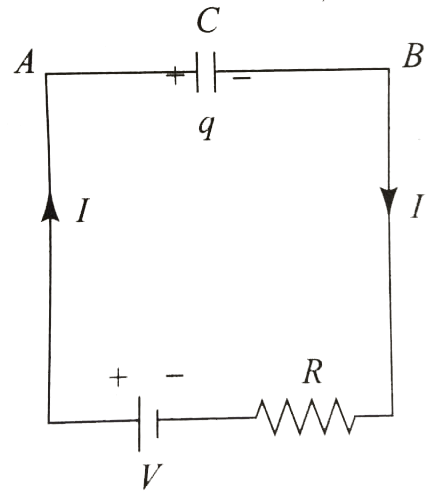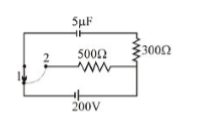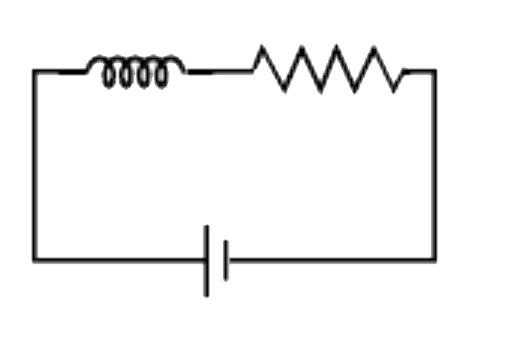A variable capacitor is adjusted to its lowest capacitance C0 and is connected with a source of constant voltage V for a long time. The resistance of connecting wires is R. At t=0, its capacitance starts to increase so that a constant current I starts to flow through the circuit. Calculate at time t,
(i) Power supplied by the source
(ii) thermal power generated in the connecting wire
(iii) rate of increase of electrostatic energy stored in capacitor
(iv) What do you infer from the above three results?
Since voltage V of the source is constant and the circuit draws constant current I from it , power supplied by the source is P=VI.
(ii) Thermal power generated in connecting wires is H=I2R.
(iii) Since the initial capacities of the capacitor was equal to C0 and it was connectws with the source for long time , initial charge on capacitor was q0=C0V. I starts to flow at t=0, at time t, charge on capacitor becomes q=(C0V+It) . At time t , the circuit will be as shown in Fig.7.22 . Potential difference across the capacitor is
Vc=VA−VB=(V−IR)→constant
Therefore , electrostatic energy in capacitor at this instant is
U=12qVc
Rate of increases of electrostatic energy is
dUdt=12Vcdqdt=12(V−IR)I
=12(VI−I2R)
But power acting across the capacitor at this instant is
P0=P−H=(VI−I2R)
while the rate of increase of electrostatic energy in the capacitor is half of it.
(iv) In fact, a force of attraction exists between the plates of the capacitor . When these surfaces move toward each other , capacitance increases. Hence , the remaining part of the paper acting across the capacitor is used to increase kinetic energy of surface ( plate) of the capacitor.

Topper's Solved these Questions
- HEATING EFFECT OF CURRENTBook:CENGAGE PHYSICSChapter:HEATING EFFECT OF CURRENTExercise:Exercise 7.1
Explore 22 Videos
- HEATING EFFECT OF CURRENTBook:CENGAGE PHYSICSChapter:HEATING EFFECT OF CURRENTExercise:Subjective
Explore 8 Videos
- HEATING EFFECT OF CURRENTBook:CENGAGE PHYSICSChapter:HEATING EFFECT OF CURRENTExercise:Thermal Power in Resistance Connected in Circuit
Explore 28 Videos
- GRAVITATIONBook:CENGAGE PHYSICSChapter:GRAVITATIONExercise:Question Bank
Explore 39 Videos
- INDUCTANCEBook:CENGAGE PHYSICSChapter:INDUCTANCEExercise:Concept Based
Explore 9 Videos
Similar Questions
A circuit consists of a source of a constant emfξ and a resistance R amd a capacitor with capacitance C connected in series. The internal resistance of the source is negligible. At a moment t=0 the capacitance of the capacitor is abruply decreased η-fold. FInd the current flowing through the circuit as a function of time t.
View SolutionA resistance (R), inductance (L) and capacitance (C) are connected in series to an ac source of voltage V having variable frequency. Calculate the energy delivered by the source to the circuit during one period if the operating frequency is twice the resonance frequency.
View Solution
Knowledge Check
Two identical capacitors are connected in series with a source of constant voltage V. If Q is the charge on one of the capacitors, the capacitance of each capacitor is :
AQ/2VBQ/VC2Q/VDNone of theseA capacitor of capacitance 5μF is connected to a source of constant emf of 200V for a long time then the swict was shifited to contact 2 form contant 1. The total amount fo heat generated in the 500ω resistance thereafter .
 A1/32JB3/32JC2/32JD5/32J
A1/32JB3/32JC2/32JD5/32JA variable capacitor is connected to an ac source. What effect does decreasing the capacitance have on the reactance and current in this circuit?
AReactance - No change , Current - No changeBReactance - Decreases , Current - No changeCReactance - Increases , Current - IncreasesDReactance - Increases , Current - Decreases
A bulb B is connected to a source having constant emf and some internal resistance. A variable resistance R is connected in parallel to the bulb. If the resistance R is increased, how will it affect the-
(a) Brightness of the bulb?
(b) Power spent by the source ?

View SolutionA charged capacitor is discharged through a resistance. The time constant of the circuit is η. Then the value of time constant for the power dissipated through the resistance will be
View SolutionA capacitor 50μF is connected to a power source V220sin50t (V in volt, t in second). The value of rms current (in ampere) is
View SolutionAn uncharged capacitor of capacitance C is connected with a battery of EMF V and a resistance R. The switch is closed at t=0. The time instant at which the current in the circuit is V4R is t=
View SolutionTime constant of the given circuit is τ If the battery is replaced by an ac source having voltage V=V0cosωt , power factor or the circuit will be

View Solution

